The effect of an AWS outage is felt immediately. When websites go down, catastrophes follow. The results include apps not working, digital payments frozen, and angry users flooding social media with reports of “something not working.” Amazon Web Services is the backbone of much of the internet’s infrastructure. When it sneezes, the whole digital world gets sick.
While the current AWS outage negatively affects business across the globe, these adverse events also present learning opportunities. Amazon Web Services and other platforms continue to refine their systems to avoid global outages. At the same time, enterprises that rely on them must build resilience to get ready for the inevitable next outage.
To explore what companies can do to make resilient systems that withstand infrastructure outages, we need to first discuss how this current AWS outage affects companies and why outages happen at all.
Key Takeaways
- AWS outages trigger immediate disruptions, affecting apps, payments, and user satisfaction.
- The interconnectedness of cloud systems amplifies the impact of AWS outages across industries globally.
- Outages result from configuration errors, networking issues, and human mistakes, highlighting systemic fragility.
- Businesses must build resilience through multi-cloud strategies, automated failovers, and effective communication plans.
- Investing in resilience fosters operational continuity, customer trust, and overall efficiency, benefiting companies in the long run.
Table of Contents
The AWS Outage Domino Effect
Every time AWS goes down, it shows the connectedness of modern cloud systems. A problem in one area shuts down businesses on the other side of the world. This is not because their servers are physically there, but because dependencies spread across APIs, services, and data pipelines.
Two previous AWS issues demonstrate the global dependency of these systems. First, in late 2021, an AWS networking problem in the Eastern US broke down. The result was a broad range of issues from security camera systems to food delivery apps. In 2023, a similar event led to problems with content delivery and storage, faulty streaming, and downed e-commerce sites.
These AWS outings have three main factors in common:
- AWS is the backbone for countless SaaS, fintech, and IoT platforms.
- Third-party integrations multiply dependencies, so one break can ripple through dozens of partners.
- Cloud centralization means resilience strategies often depend on the same provider — an irony that’s becoming impossible to ignore.
An AWS outage isn’t just a technical issue; it’s a wake-up call for the digital economy.
What Causes AWS Outages
No cloud service is immune to downtime and outages. AWS has a great uptime record of 99.99%, thanks to its huge global presence. But even with only one-thousandths of a percent error rate, there is still room for a few hours of downtime each year.
Some common causes are:
- Configuration or deployment errors – A single misconfigured update can cascade across servers.
- Networking failures – Routing or load-balancing problems can isolate regions.
- Overloaded systems – Surges in traffic can cause services to throttle.
- Power and cooling issues – Rare, but they happen even in top-tier data centers.
- Human error – Despite automation, people still play a role in maintenance and failover execution.
AWS spends billions on infrastructure, redundancy, and automation, but outages will still happen. This isn’t because of incompetence; it’s because the more complexity a system has, the more fragile it becomes.

Cloud Resilience Lessons
Every time AWS goes down, businesses build on their knowledge of how to be strong. The best companies don’t just deal with downtime; they plan for it.
This is what modern resilience looks like:
1. Build a Scaffold for Failure
Systems should be built with the assumption that components will fail. That means designing distributed architectures where no single point of failure can cripple operations. Using multiple Availability Zones (AZs) within AWS is a start, but smart teams go further.
2. Strategies For Multiple Regions and Clouds
Many businesses are moving toward hybrid or multi-cloud environments, combining AWS with other providers like Google Cloud or Microsoft Azure. This approach ensures that if one platform experiences an outage, critical workloads can shift elsewhere.
Of course, multi-cloud adds complexity and cost, but it’s becoming a competitive advantage — particularly for enterprises in finance, healthcare, and logistics.
3. Monitoring Beyond the Cloud Console
AWS CloudWatch is a great tool, but outside monitoring tools can find problems sooner. Independent observability platforms give teams real-time information, even when AWS’s own dashboards are slow.
4. Failover and Recovery That Happens Automatically
Recovering by hand takes time and trust. Companies that automate failover between clouds or regions can cut down on downtime by a lot. The most important thing is to test those systems often, not just set them up once and hope they work.
5. Plans For Communication are Important
Many businesses find out during an AWS outage that they don’t have a clear plan for how to communicate. Customers, investors, and partners need to be kept up to date. Silence hurts reputations faster than being down does.
AWS’s Changing Role in Resilience
AWS has learned from every outage, which is a good thing. Over the years, Amazon has:
- Expanded regional diversity and fault isolation.
- Introduced new monitoring and failover tools.
- Enhanced transparency through the AWS Health Dashboard.
- Improved network redundancy and incident response speed.
The company can’t promise that everything will be perfect, though. With the shared responsibility model, AWS takes care of the infrastructure, and customers take care of their own configurations. This means that both sides are responsible for resilience.
Companies that think of the cloud as something they can “set and forget” are the most at risk. People who know how to deal with their own problems, practice failovers, and plan for chaos do well even when things go wrong.
The Business Case for Resilience
When there is a major AWS outage, the costs are much higher than just lost transactions. Costs include damage to the company’s reputation, exposure to regulations, and disruption within the company. For digital-first businesses, even a short outage can cost them thousands or millions of dollars.
There are three main areas where resilience pays off:
| Benefit | Description |
|---|---|
| Continuity | Keeps mission-critical operations running during outages. |
| Trust | Customers stay loyal when they see quick, transparent responses. |
| Efficiency | Automation reduces the cost and chaos of manual recovery |
Putting money into resilience isn’t a way to protect yourself; it’s a way to grow. Customers, investors, and new ideas all come to businesses with reliable systems.
Getting Ready for the Next AWS Outage
It’s not a matter of if there will be another AWS outage, but when. Companies can’t control Amazon’s infrastructure, but they can control how ready they are.
- Cloud leaders, here’s a list of things to do:
- Audit every dependency on AWS services.
- Simulate outage scenarios and test failover systems.
- Document clear communication and escalation protocols.
- Diversify workloads where possible.
- Track performance and incident response metrics.
Resilience isn’t a project with a deadline; it’s a discipline that changes over time.
Final Thoughts
When AWS goes down, it reminds people in the tech world that digital reliability isn’t automatic; it’s built. The cloud has changed the way we think about scalability and innovation, but it has also made risk more concentrated.
The good news? Every outage makes the industry better. Cloud resilience is becoming more than just a technical goal; it’s also a cultural one. Success is now defined by being ready, open, and flexible.
When the next AWS outage comes — and it will — the companies that view it as an opportunity to strengthen their systems will come out ahead.











